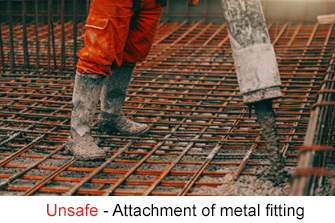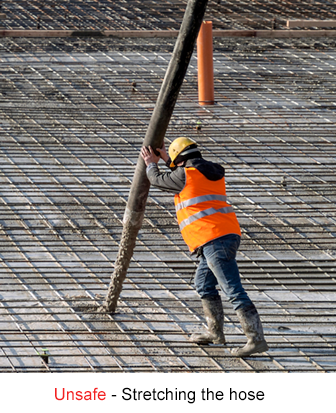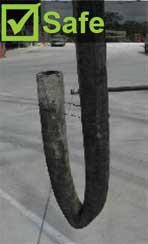Hose whipping is a serious risk associated with operating a concrete pump.
'Hose whip' describes the uncontrolled and rapid motion of the flexible rubber hose on the end of a concrete placement boom or other concrete delivery line.
Workers may sustain an injury and sometimes death either by being struck by the whipping hose or by being knocked over and hitting the ground or an object. An incident may happen when trapped air is momentarily compressed and then released causing the hose to whip violently.
Understanding why hose whip occurs and the control measures required will minimise hose whipping at the workplace.
Hazards and risks
Hose whipping is caused by air being trapped in the delivery system. A hose whip can occur during the concrete pumping operation or when the line is being cleaned out. Hose whip can be especially violent when air enters the line and becomes pressurised by the pumping process.
Air can be introduced into the delivery system when:
- the pump is initially started
- restarting after relocation
- the concrete level falls below the valve
- the pump is pumping faster than concrete is being delivered
- the pump continues to pump after the delivery is completely discharged
- a blockage is cleared
- the hose is poorly maintained, or
- concrete is allowed to free fall after the pump is shut off.
The selection of suitable plant and safe systems of work can reduce the likelihood of hose whip and taking additional risk control measures can reduce the likelihood of injury.
Controlling the risk
There are a number of precautions that you can take to minimise the likelihood of injury from hose whip.
Preparing the site
- Prepare and implement a Safe Work Method Statement (SWMS) to minimise the hazards and risks associated with High Risk Construction Work.
If you are a Principal Contractor ensure you have arrangements in place for the collection, assessment, monitoring and review of the safe work method statement. - Select workers who are well trained and competent to pump concrete and clear blockages.
- Check the work site around the work area to reduce the likelihood of trip hazards.
- Inspect the hose to confirm that it is fit for purpose before being used
Ensure the hose is periodically tested by a competent person for internal degradation. Hoses deemed to be at the end of their life should be rendered unserviceable and discarded to prevent further use - Never attach metal fittings to the free end of the rubber delivery hose.

Preparing for the pour
- Ensure all workers are wearing appropriate personal protective equipment, including hard hats.
- Ensure the delivery hose can reach the pouring location without stretching.
If the boom is not long enough to reach the concrete pour area, a larger boom should be used or the concrete pump should be moved closer to the job. - Clear any person not involved in the concrete pour from the delivery hose area (exclusion zone).
- Only use concrete that is a pumpable mix as specified by the concrete supplier. Other mixes of concrete can block the line and cause hose whip.
- Start the pump up slowly to reduce the likelihood of hose whip.

Pouring
- Provide a safe area in which the line hand can stand. The width of the working surface should be at least 450mm.
The line hand should not stand on block walls or next to unprotected edges. - Ensure the delivery hose on a boom pump hangs close to vertical and only guided by the line hand.
- Monitor the level of concrete in the hopper to avoid air getting sucked in the pump system.
Make sure a separate person to the line hand is in position to view the hopper. This will normally be the pump operator. - Do not let the concrete solidify in the line as this will cause blockages. The concrete needs to remain in its plastic state.
- Do not allow concrete to drop out of the hose when pumping is stopped.
Fold the hose over to prevent concrete dropping out and air being able to enter the system.

Clearing blockages and cleaning
- Secure flexible hoses on line pumps when priming or clearing blockages to eliminate the risk of hose whip.
- Clean out the concrete line with water instead of air.
- When there is no other option but to clean the pump line out with air, secure the end of the steel line and have an exclusion zone.
Remove all reducers and the rubber hose from the end of the delivery line. Fit a ball catcher or cage to the end of the steel pipe. This will contain the blow out plug (i.e. sponge) as it is ejected from the line.
Review controls
Review your control measures regularly to ensure they are effective and working as planned. When reviewing control measures, take into consideration any changes in processes, procedures, equipment or personnel and the nature and duration of work.
Further information
For further information and advice on complying with legislative requirements, call us on 1300 365 255. You can speak to one of our friendly Workplace Advisors, who can provide you with WHS information, practical advice, support, and even visit you at your workplace.
Approved Code of Practice: AS 2550.15:2019 Cranes, hoists and winches – Safe use – Concrete placing equipment
Concrete pumping – Safe Work Australia
Guide to managing risk in construction: Concrete pumping – Safe Work Australia
Concrete pumping Code of Practice 2019 – WorkSafe QLD


